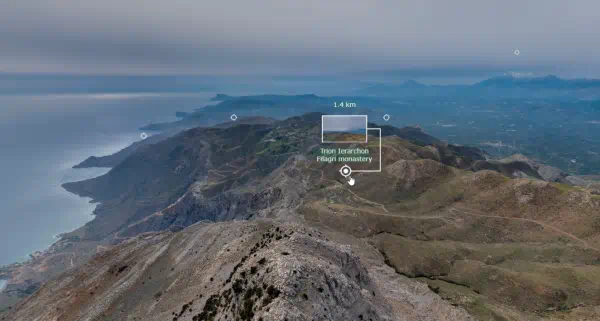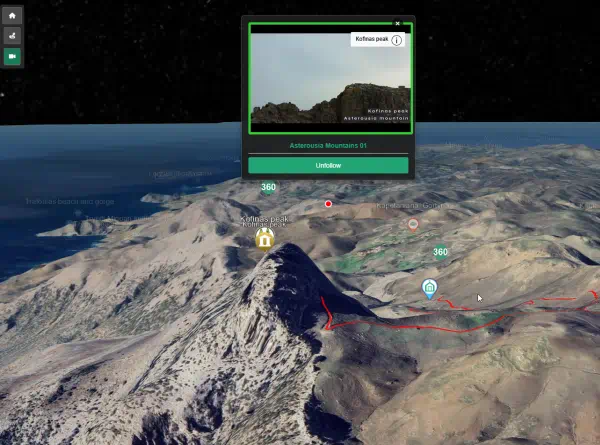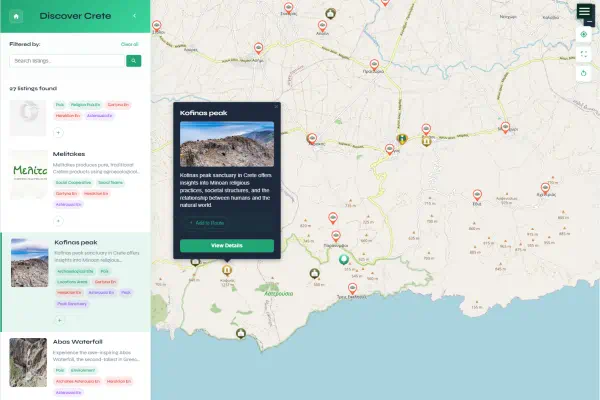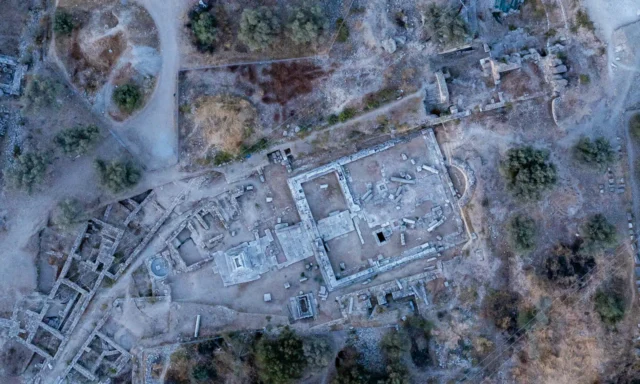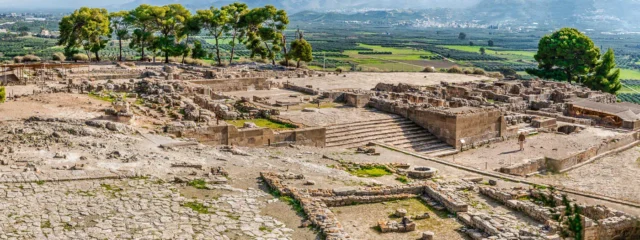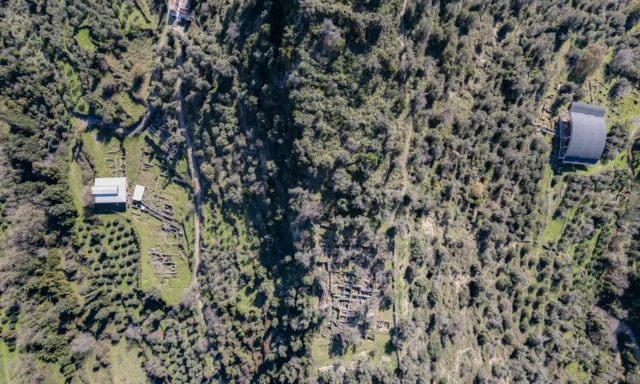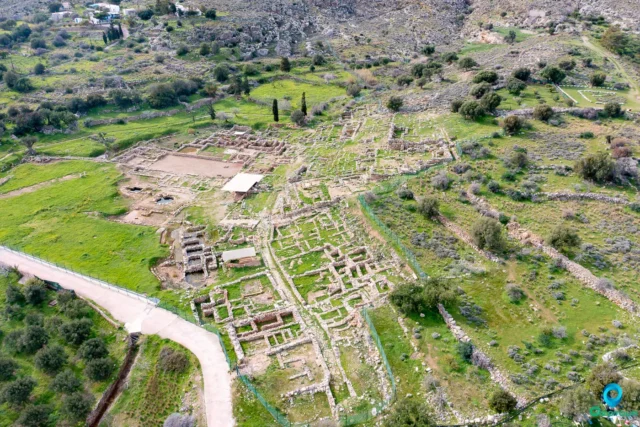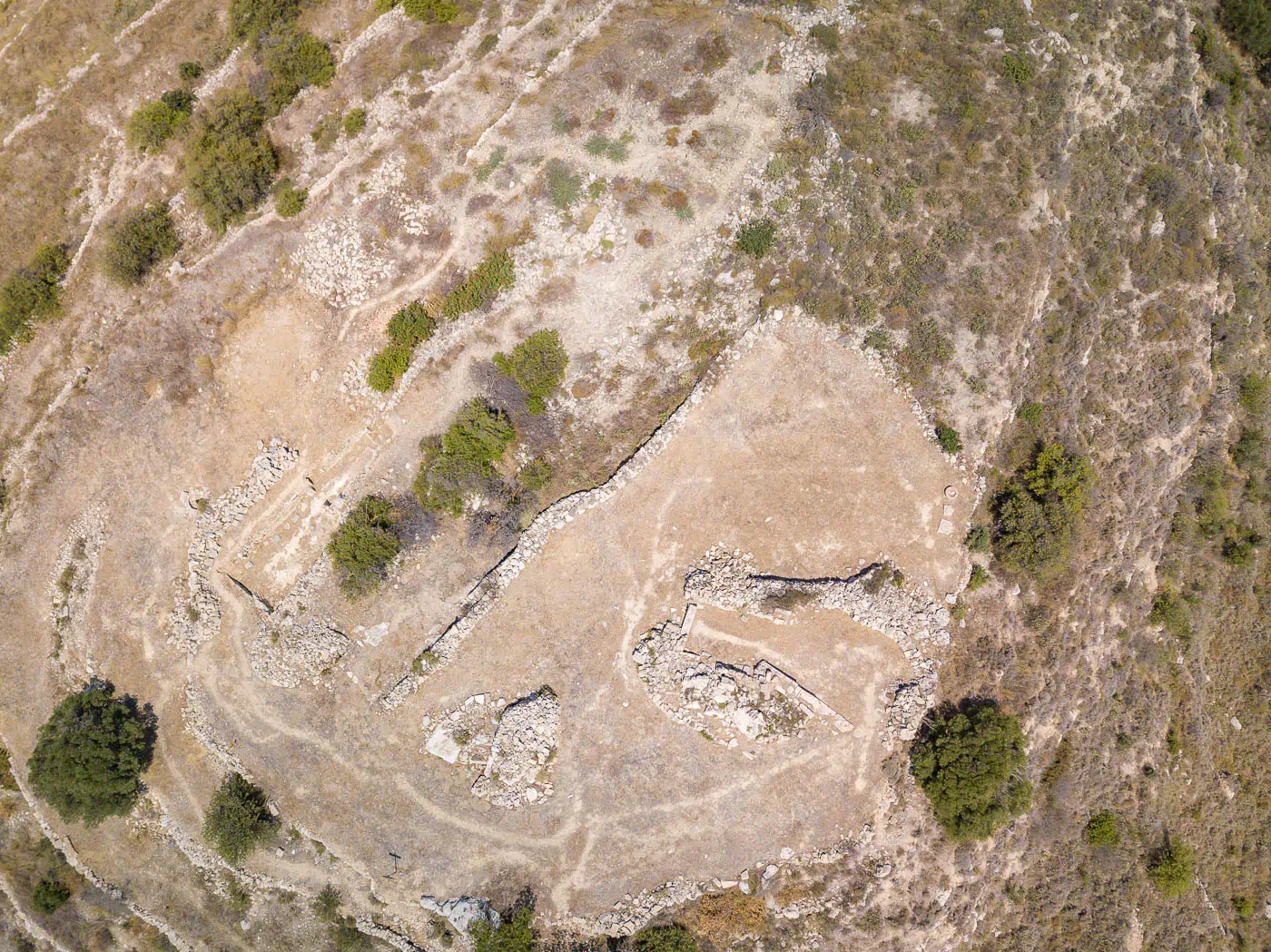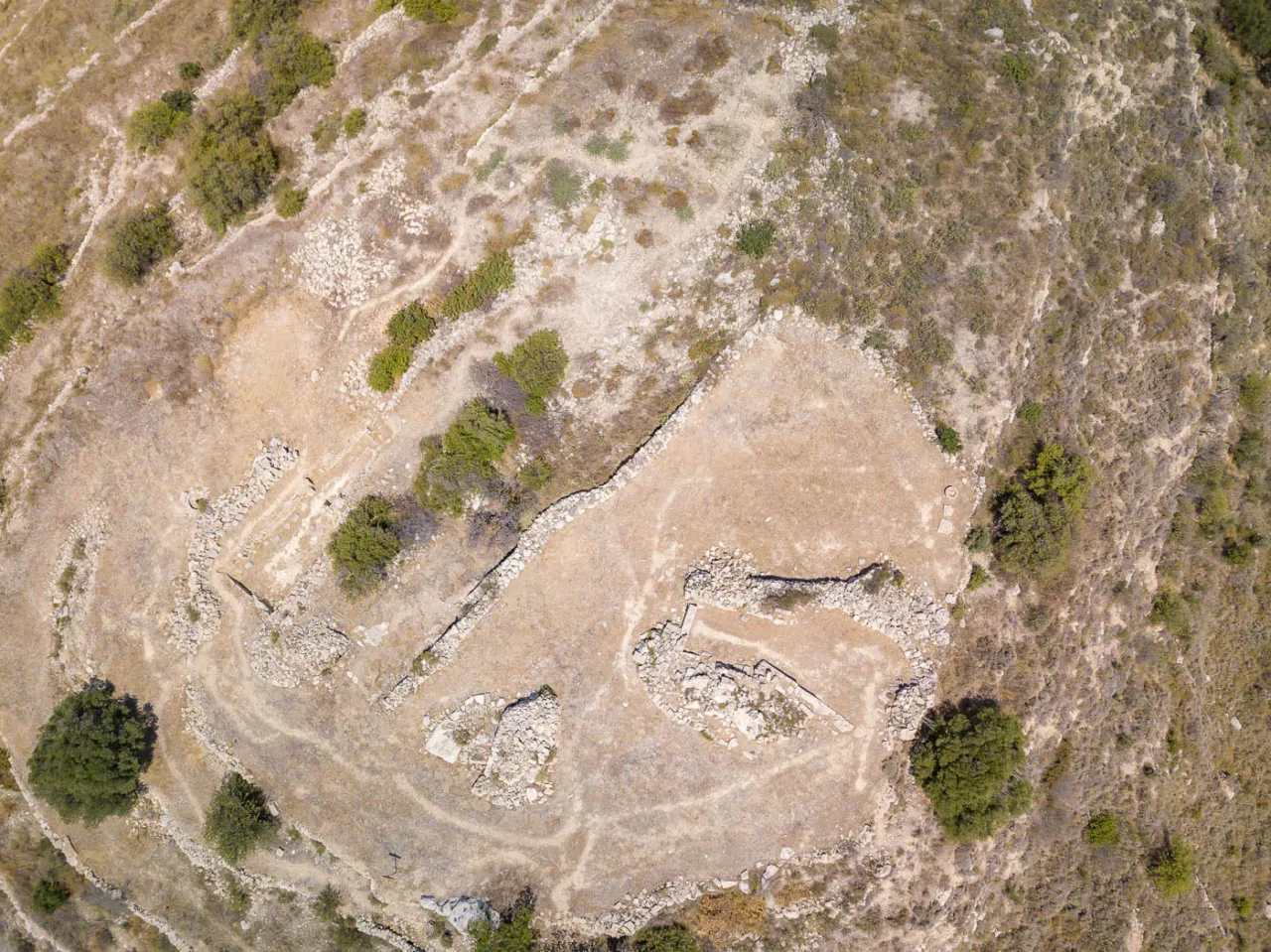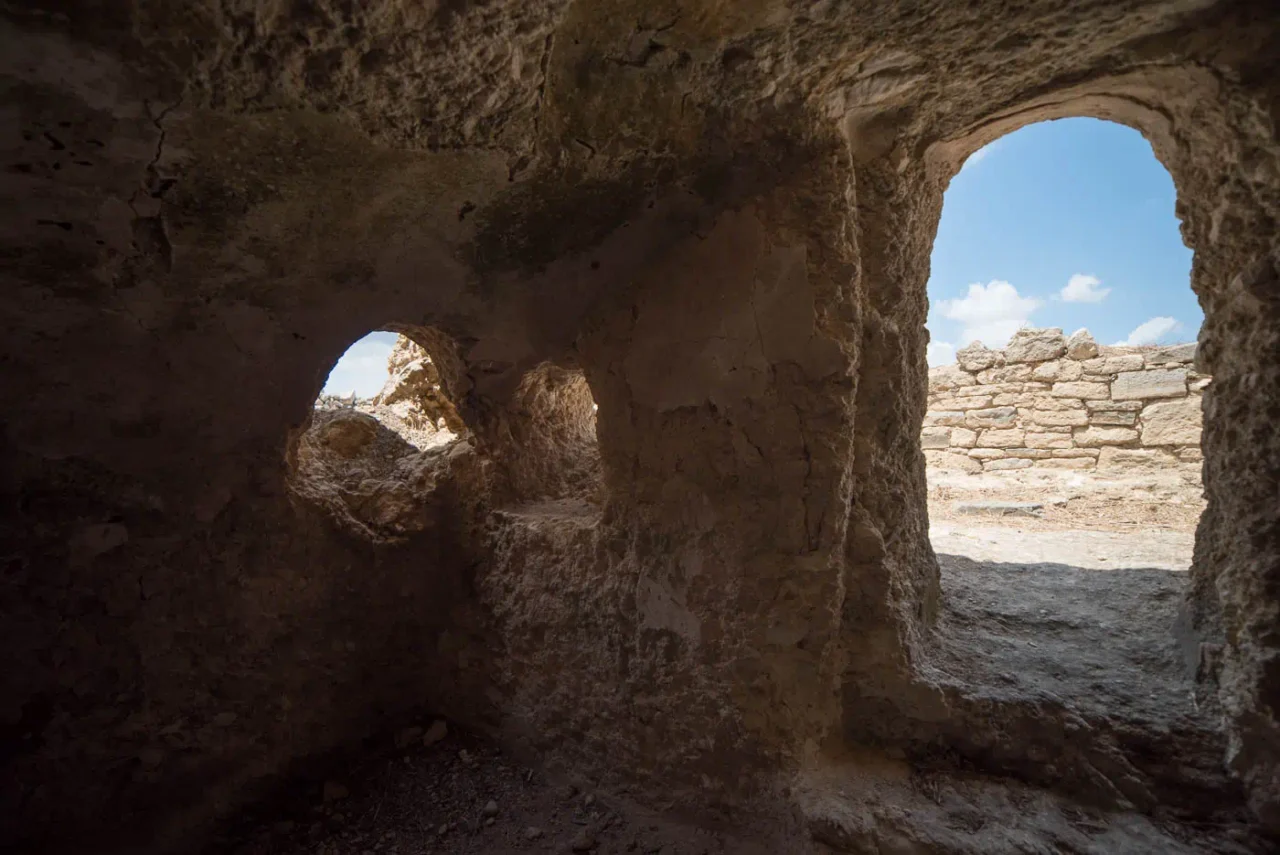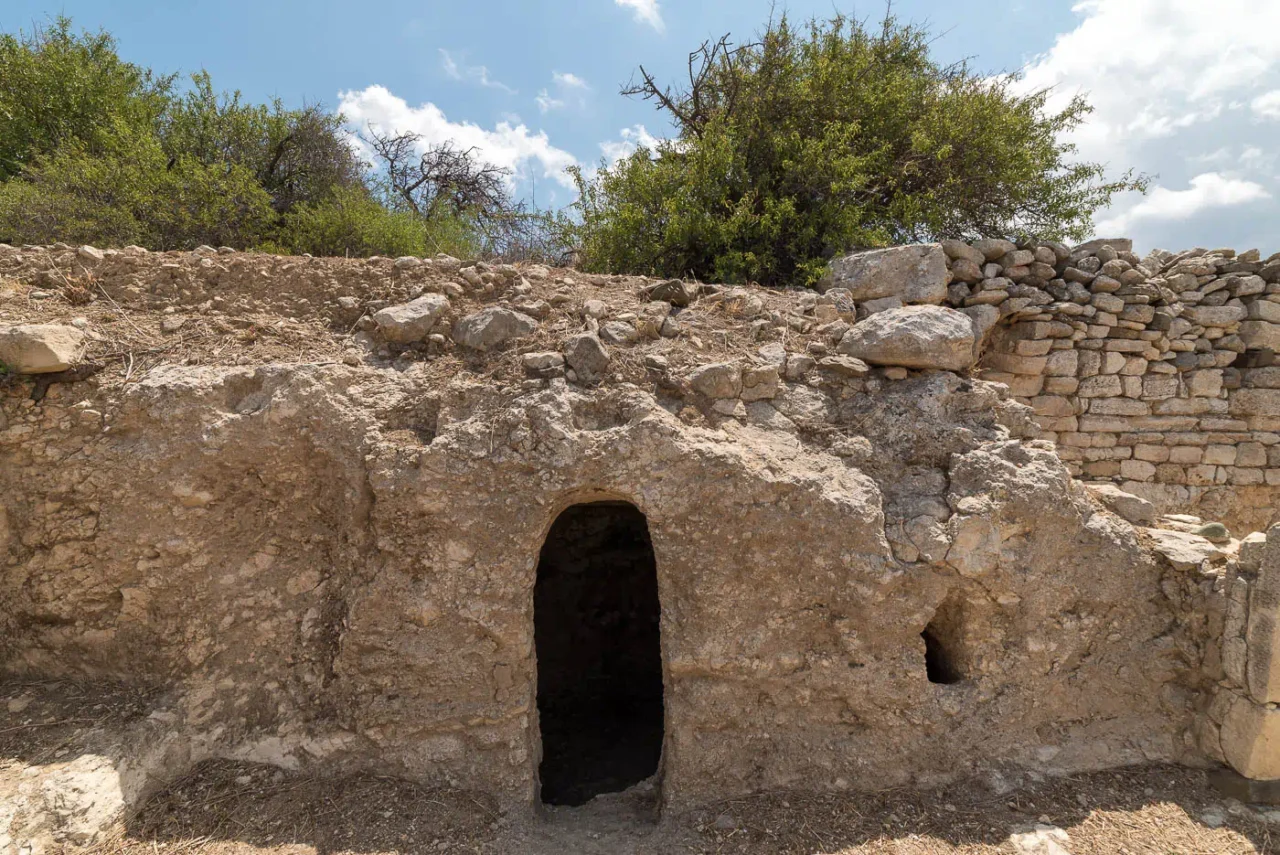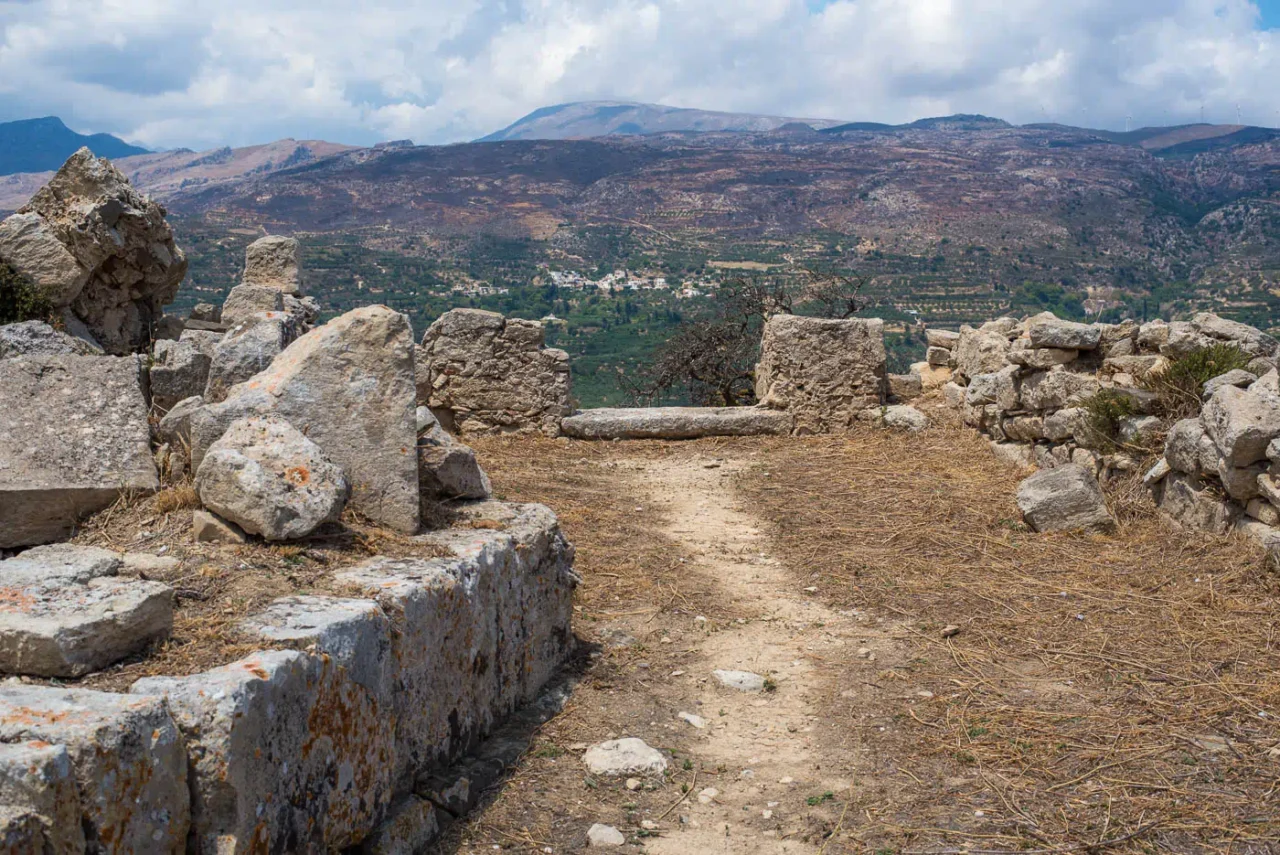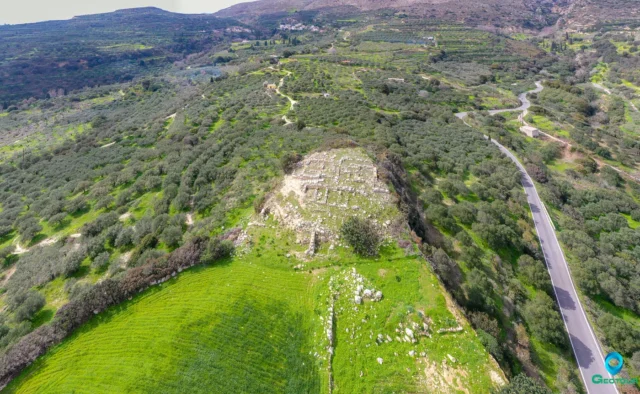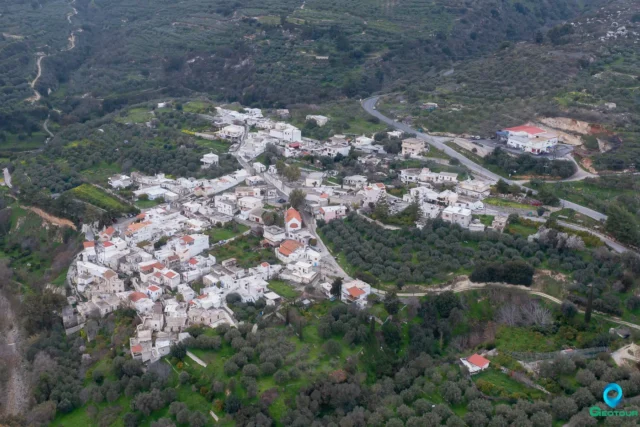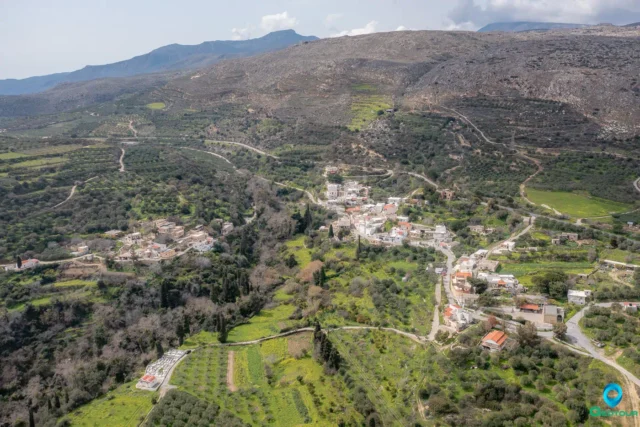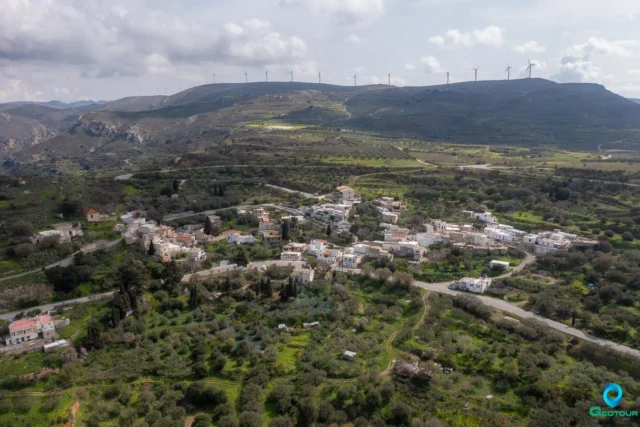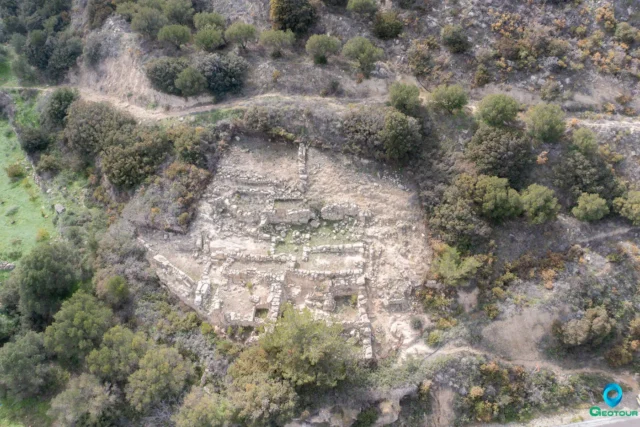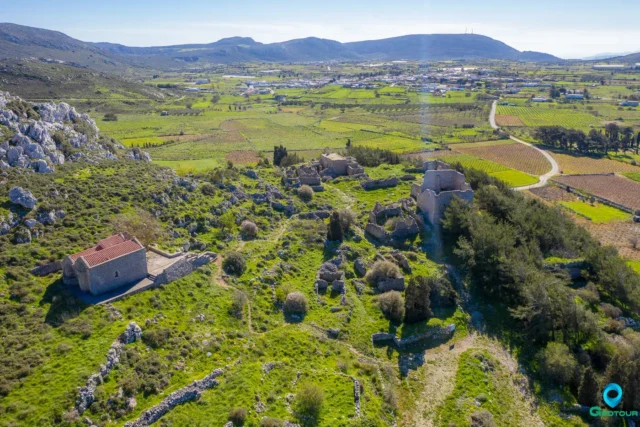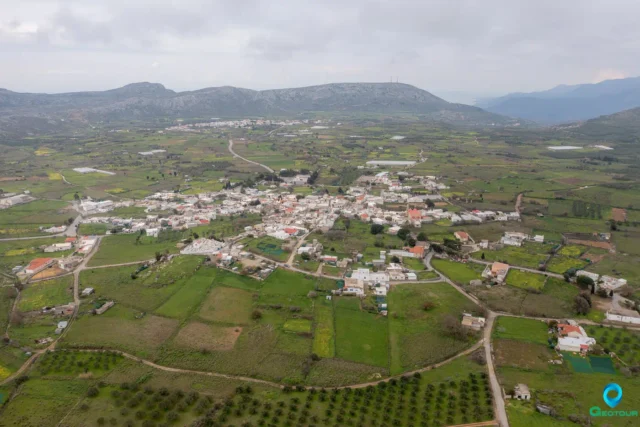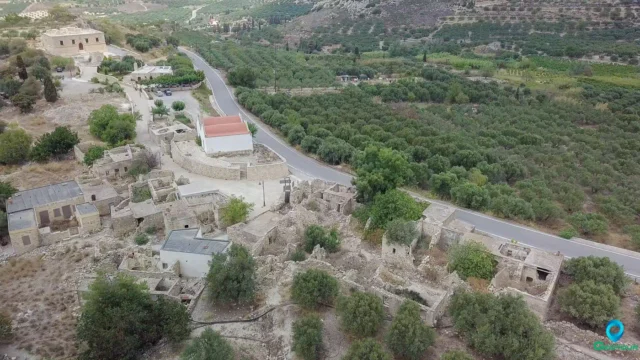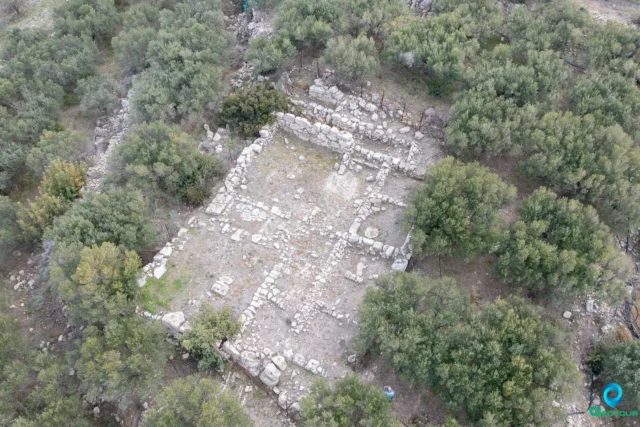Praisos is situated in eastern Crete, nearly midway between the north and south coasts, at the head of a fertile valley that extends south from Siteia. More specifically, it lies in the heart of the Siteia peninsula, beyond the Thrypti range. The site occupies two low hills, forming a characteristic double acropolis, a feature also found at Lato and Dreros. The ancient city is located on a rocky, tongue-shaped plateau almost enclosed by two streams that converge at its base to form the Siteia river. This peninsula descends in formidable cliffs on the north and west. The study zone of the Praisos corridor extends from the bay of Siteia in the north to the bay of Makrygialos in the south, with Praisos at its center.
Praisos was an important settlement in eastern Crete from the Late Minoan period through to its destruction in the Hellenistic period. Notably associated with the Eteocretans, who considered themselves the original Cretans, Praisos has been the subject of archaeological investigations since the late 19th century. These investigations have revealed information about its occupation phases, material culture, and its role within the broader historical context of Crete. The settlement evolved through various periods, experiencing phases of growth and ultimately destruction by Hierapytna around 140 BCE.
Historical Periods
- Neolithic Period: Evidence suggests occupation at Praisos dating back to the Neolithic period.
- Late Minoan (LM) Period: The site shows evidence of Late Minoan occupation, including tombs (specifically LM IIIb-c) such as the one at Photoula, and a significant ‘refuge settlement’ at Kipia above Kalamafki (LM IIIc). Walls located on the first acropolis are also attributed to this phase, some belonging to houses and others possibly serving as fortification.
- Archaic Period (c. 700 – 500 BCE): By the end of the Archaic period, the settlement of Praisos had likely attained a considerable size. Walls on the summit of the first acropolis and some rock-cut features on its lower slopes are dated to this period. Finds from the sanctuary on the Third Acropolis(Altar Hill), such as bronze tripod legs, also seem to date to around 700 BC. Praisos was a forming city-state during this time, with surrounding sanctuaries indicating its territorial expression and growing regional identity. Archaic and Classical inscriptions found on the third acropolis, written in Greek letters but in a separate (Eteocretan) language, highlight a distinct linguistic identity.
- Classical and Hellenistic Periods (5th – 2nd centuries BCE): Praisos flourished as the sole inland Greek city-state of far eastern Crete. It controlled a large territory including subordinate communities like Stales and Dragmos. While not possessing a city wall itself, a fort near Epano Episkopi (Trypitos) controlled the northern approach to the city. Inscriptions from this period continue to show the use of the Eteocretan language alongside Greek. However, by the later Hellenistic period, Greek inscriptions become more prevalent in public contexts. The city’s occupation ended with its destruction by Hierapytna between 146 and 140 BC. The abandonment involved forced departures and deliberate demolition of structures, including the smashing and leaving behind of storage pithoi.
- Middle Byzantine Period (961-1204 CE): After a long period of abandonment following its destruction in the Hellenistic period, the Praisos area was reoccupied during the Middle Byzantine period. Evidence from this time includes architectural remains like religious buildings and bath complexes, as well as surface ceramic material, suggesting the presence of small agricultural settlements and fortified sites like Monte Forte. Epano Episkopi, located near the site of ancient Praisos, may have been the seat of the diocese of Sitia during this period.
- Venetian Period (1204-1669 CE): The Venetian period saw continued occupation in the broader Praisos corridor, with a significant number of villages recorded in censuses. While the fertile plains near the coast were not always densely populated, settlements were scattered inland, often prioritizing defensible locations and access to water. Monte Forte continued to be used, and a village developed at Gras. Archaeological surveys, including the Praisos project, have documented some material remains from this period. The village of Praisos itself existed as a Venetian village called ITpao-oo- south of the First Acropolis.
Historical Periods
Transformations in the Praisos Region: From the Late Bronze Age to Venetian Rule
The history of the Praisos region in eastern Crete reveals a dynamic pattern of settlement, cultural development, and political upheaval, spanning from the Late Minoan period through the era of Venetian dominance. Archaeological and textual evidence from the provided sources allows us to trace these significant transformations.
Late Minoan Instability and Settlement Shifts
The close of the Bronze Age, specifically the Late Minoan IIIC period (circa 1200-1100 BCE), marked a time of considerable upheaval across the eastern Mediterranean. In Crete, this era witnessed a notable shift in settlement patterns, moving away from coastal rural areas towards more defensible locations with strategic visual control over both land and sea routes. This period is characterized by the establishment of significant LM IIIC ‘refuge settlements’, such as the one at Kipia [Key Historical Events]. While the sources do not explicitly detail the Kipia settlement, the general trend of establishing fortified locations at this time suggests a period of regional instability and population movements in eastern Crete, potentially affecting the area around Praisos. Interestingly, a site located within two kilometers of Praisos shows occupation corresponding to a time when larger Minoan towns in eastern Crete were being abandoned, yet before the major period of occupation at Praisos itself. This site was abandoned by 900 BC, before the Geometric period. This suggests a transitional phase in the region following the broader Late Bronze Age changes.
The Emergence of Eteocretan Identity in the Archaic Period
By the Archaic period (roughly 700-500 BCE), the Praisos region had emerged as a significant center, laying the foundation for a distinct Eteocretan identity [Key Historical Events]. This identity is evidenced in several ways. Firstly, the inhabitants of Praisos in later times considered themselves to be the “original” Cretans, a claim reported by Herodotus. While the term Eteocretan is not used by Herodotus in this context, Strabo, drawing on the historian Ephorus, explicitly links Praisos with the Eteocretans. The most compelling evidence for a separate Eteocretan identity comes from the discovery of inscriptions dating from the late Archaic to the early Hellenistic period around the Altar Hill or Third Acropolis of Praisos. These inscriptions, though written in the Greek alphabet, are not in the Greek language and have been identified as Eteocretan. This linguistic difference suggests a genuine sense of distinctiveness among the inhabitants of this part of eastern Crete. Furthermore, the presence of several Archaic sanctuaries surrounding Praisos underscores its importance as a developing center during this period and highlights the formation of a regional identity. These sanctuaries acted as elements of territorial expression, contributing to the construction and maintenance of this distinct Eteocretan identity. However, it is also important to note that the material culture of Archaic Praisos, such as terracotta finds, does not significantly differ from other parts of Crete, often being described as Daedalic in style.
Praisos as a Flourishing Inland City-State in the Classical Period
The Classical period (5th and 4th centuries BCE) witnessed Praisos flourishing as the primary inland Greek city-state in eastern Crete, controlling a notable territory. Located inland, approximately 250 meters above sea level and beyond the Thriphte range in the heart of the Siteia peninsula, Praisos occupied two low hills, a characteristic double acropolis also seen at Lato, Dreros, and other Cretan cities. Despite being inland, access to the sea was crucial for its survival, and Praisos actively pursued territorial expansion to secure maritime outlets. By the beginning of the 3rd century BC, Praisos had gained control over several other cities, including Setaia (modern Sitia), Polichna (likely at Trypitos), Stales, and Ampelos (modern Xerokampos). Dragmos was probably conquered later in the 3rd century BC. By the mid-4th century BC, it was even claimed that Praisos governed both sides of the island, indicating its significant power and influence. However, unlike many other Cretan poleis, Praisos itself did not have a city wall, although a Classical-Hellenistic fort in its vicinity controlled the route leading to the north coast. The ambition of territorial expansion and the pursuit of maritime access ultimately put Praisos in conflict with its neighbor to the west, Hierapytna, which also followed an expansionist policy.
Hellenistic Destruction and the End of a Polis
The Hellenistic period culminated in the destruction of Praisos by Hierapytna between 145 and 140 BC. This event was not an isolated incident but part of a broader pattern of destructions of Cretan poleis during the 2nd century BC, also affecting Dreros, Apollonia, and Phaistos. The archaeological evidence from excavations at Praisos suggests a forced abandonment of houses and the deliberate demolition of remaining structures, rather than widespread destruction by fire. Intriguingly, large storage vessels (pithoi), often older than the houses they were found in, were abandoned in situ, a phenomenon also observed at other destroyed Cretan sites like Dreros and Phaistos. This abandonment of household pithoi is interpreted as a significant marker of the end of the household unit and, consequently, a key element in the eradication of the political community. Furthermore, votives from the sanctuaries in and around Praisos do not seem to date from a period after 140 BC, indicating a targeting of the city’s cults, another crucial aspect of its political and social identity. The literary sources, particularly Strabo, use the verb κατέσκαψαν to describe the destruction of Praisos by Hierapytna. This term, according to scholarly interpretation, carries a connotation of a ritual dimension to the destruction of a political community, involving not just the physical razing of the settlement but also the dismantling of its social and political fabric. Following its conquest, Praisos was not reoccupied as a significant settlement, and its identity as an independent political community ceased.
Middle Byzantine Reoccupation and Shifting Settlement Patterns
After a long period of apparent abandonment following its destruction in the Hellenistic period, the Praisos area witnessed reoccupation during the Middle Byzantine period (roughly 961-1204 AD). While the literary sources of this era provide little information about the region, archaeological evidence reveals the establishment of smaller agricultural settlements on hilltops and slopes, as well as fortified sites in strategic locations along the north-south passage of the Praisos corridor. Excavations at Petras, near the coast to the north, uncovered a Middle Byzantine cemetery, suggesting the presence of a small community in the vicinity, even though a corresponding settlement has not yet been found. Inland, in the Praisos area itself, the village of Epano Episkopi, located about 1.5 km northwest of the ancient site, appears to have been the seat of the diocese of Sitia during this period. Architectural remains, including religious buildings and bath complexes, along with surface ceramic finds, attest to this renewed activity. The construction of fortified sites like Monte Forte in the center of the corridor and Agios Stephanos (Gras) further south indicates a concern for security during this time, potentially linked to threats from the sea. This reoccupation, however, did not see the resurgence of Praisos as a major urban center, but rather a dispersal of smaller communities exploiting the agricultural potential of the region.
Venetian Presence and Village Life
The Venetian period (1204-1669 AD) brought significant changes to Crete, with the island becoming a crucial colony for the Venetian Republic. During this time, a Venetian village named ITpao-oo- existed on the level ground south of the First Acropolis of ancient Praisos. The broader Praisos corridor was populated with numerous villages, as evidenced by a wealth of written sources, including feudal records and census registers. These records, particularly the census of 1583, provide detailed information about the names and populations of these villages. Archaeological surveys, including the Praisos project, have also identified sites and material remains from this period. Smaller settlements and structures, such as hamlets, “metochia,” farmhouses, monasteries, and watermills, were used for habitation and agricultural activities in the valleys of the Pantelis and Andromylos rivers. Despite Venetian efforts to promote intensive agriculture in flat areas, many villages were located on steeply sloping terrain, suggesting that access to water sources, security, and visual control of the surroundings remained important factors in settlement location. The fortress of Monte Forte continued to serve as a significant defensive site in the 13th and 14th centuries. While Sitia was the main urban center of the region, the Praisos corridor itself saw a widespread network of smaller rural settlements, reflecting a decentralized pattern of occupation during the Venetian period.
Archaeological Discoveries
- Early Investigations: The site was first investigated by Halbherr and Comparetti, who focused on the sanctuary on the Third Acropolis. More extensive investigations were undertaken by a British team under R. C. Bosanquet in 1901. These early excavations revealed important inscriptions and architectural remains.
- Late Minoan Finds: Discoveries include LM IIIb-c tombs, such as the one at Photoula where fragments of a painted larnax were found. The LM IIIc ‘refuge settlement’ at Kipia yielded pottery including characteristic ‘tripod legs’.
- Archaic and Classical Inscriptions: The discovery of inscriptions in Eteocretan language (using Greek letters) from the Archaic and Classical periods has been crucial in understanding the unique identity of Praisos. These inscriptions were found in various locations, particularly around the Third Acropolis.
- Architectural Remains: Excavations have revealed walls dating from the Late Minoan to the Hellenistic periods on the First Acropolis, including possible fortification walls and house structures. Remains of what Bosanquet termed the ‘Andreion‘ or ‘Almond Tree House’ have also been a focus of recent investigations. Archaic walls and rock-cut features have been identified on the First Acropolis. In the Middle Byzantine period, evidence of religious buildings and bath complexes has been found.
- Notable Artifacts: Finds include pottery from various periods (Minoan to Hellenistic and later), bronze tripod legs from the Altar Hill dating to around 700 BC, loomweights, and storage pithoi, some dating back to the Archaic period and found in Hellenistic contexts. A bronze coin provided a terminus post quem for the abandonment of some Hellenistic houses. Three short inscriptions, likely in Greek, were discovered during the 2007 excavations.
- Survey Data: More recent survey projects, including an EDM survey in 1992 and fieldwalking surveys in 1993, 1994, and 1998, have aimed to determine the broader settlement history of the area.
- Current State: The site consists of the First, Second, and Third Acropoleis, with visible architectural remains. The main layers of habitation were on the first and second acropoleis, while the third was the location of the sanctuary. Modern terraces overlay some of the ancient remains. The location of the ancient city is known, and ongoing research continues to shed light on its past.
Cultural and Economic Context of Praisos
The Unique Eteocretan Identity
Praisos holds a distinctive place in the history of Crete due to its strong association with the Eteocretans. This group, mentioned by Homer in the Odyssey, were considered one of the five peoples of Crete. Notably, the inhabitants of Praisos, according to Herodotus, recounted a story that distinguished them from other Cretans, potentially validating their claim to be the ‘true’ or ‘original’ Cretans. While Herodotus did not use the term Eteocretan, the connection between Praisos and the Eteocretans is evident in the writings of Strabo, who appeared to draw information from the historian Ephorus.
The distinct identity of the Praisian people was dramatically underscored by the discovery of the Eteocretan inscriptions in the late nineteenth century by Italian epigraphists. These inscriptions, found around the Altar Hill or Third Acropolis of Praisos, date from the late Archaic to the early Hellenistic period and are written in the Greek alphabet but in a language other than Greek. This linguistic difference suggests that the Praisian or Eteocretan inhabitants may have been genuinely ‘ethnically’ different from other contemporary Cretans in the Archaic period. Indeed, the Praisian people themselves imagined they were different, and this imagined difference is considered by some scholars as the true marker of ‘ethnicity’. The retention of this non-Greek language, possibly for ritual purposes, into the fourth century BC, along with the ‘myth of descent’ narrated by Herodotus, supports the notion of Praisos as a distinct ethnic and political community at the time of its destruction. This unique perceived ancestral connection and language significantly contributed to a strong local identity in Praisos.
Economic Activities
The geographical setting of Praisos, at the head of a fertile valley, strongly implies that agriculture formed a crucial basis for its economy. The presence of storage pithoi found during excavations, particularly in domestic contexts and a possible sanctuary storeroom on the First Acropolis, indicates the storage of agricultural produce. These large storage vessels were seemingly associated with households in eastern Crete, and their abandonment during the city’s destruction suggests a disruption of the social and economic units.
The discovery of loomweights during the 2007 excavations on the north-west slopes of the First Acropolis points towards textile production as another economic activity within the settlement. This suggests a degree of craft specialization and possibly domestic industry in Praisos.
Looking at the broader temporal context, during the Venetian period, the Praisos region, like much of Crete, was characterized by intensive agricultural exploitation. Villages were often situated in proximity to fertile land and reliable water sources, highlighting the continued importance of agriculture in the local economy. While the ancient city of Praisos was not reoccupied until the Middle Byzantine period, the surrounding area saw patterns of agricultural settlements.
Sanctuaries and Cult
Praisos was an important religious center, evidenced by several sanctuaries in and around the city. The primary sanctuary was located on the Third Acropolis, also known as the Altar Hill. Archaeological finds from this site, dating back to the Archaic period, include bronze armor (both full-scale and miniature) and terracotta figures that adorned a balustrade marking the altar. Notably, the laws of the Praisian political community, written in both Greek and Eteocretan, were originally displayed on this balustrade. The Altar Hill is unique in the vicinity for providing clear evidence of open-air animal sacrifice.
Other sanctuaries existed in the surrounding territory, particularly dating to the Archaic period, indicating the city’s significance as a center of a forming city-state. These sanctuaries played a role in territorial expression and the construction of regional identity. Examples include a sanctuary near the ‘spring at Vavelloi’ and another at Anoixe near Roussa Ekklesia. The terracotta plaques, often with distinctive masculine iconography linked to male initiation, found at these spring shrines and other locations, suggest important cultic practices.
Intriguingly, the archaeological record suggests a cessation of activity at these Praisian sanctuaries around 140 BC, coinciding with the destruction of the city by Hierapytna. This abrupt end to votive depositions and cultic practices in the urban and extra-urban sanctuaries marks a significant aspect of the city’s demise as a political and cultural entity.
Urban Structure
The ancient city of Praisos was situated inland and occupied three acropoleis. The main areas of habitation were located on the first and second acropoleis, while the third acropolis served as the location of its primary sanctuary, the Altar Hill. The site benefited from a strategic location amidst valleys formed by tributaries of the Pantelis river, with numerous springs providing water.
Recent archaeological investigations, particularly the 2007 excavation season, focused on understanding domestic space and urban structure, primarily on the north-west slopes of the First Acropolis. This work centered around a large structure with an imposing façade of ashlar limestone blocks, referred to by Bosanquet as the ‘Almond Tree House’ or ‘Andreion’, suggesting a potential civic function. Excavations aimed to define the last phase of settlement before the city’s destruction.
A notable feature of Praisos is the apparent absence of a city wall surrounding the main settlement, placing it among the Cretan cities that were not fortified. However, a Classical-Hellenistic fort has been identified nearly 1 km east of the village of Epano Episkopi at a site called Trypitos. This fort commanded a view over the Pantelis valley, controlling the approach to Praisos from the north and suggesting a strategy of territorial defense despite the lack of direct fortification of the urban center. This suggests that while the city itself may not have been walled, the surrounding landscape included defensive structures to control access.
Praisos’s Connections to Crete
Geographical and Political Significance
Nestled in eastern Crete, the region around Praisos held considerable importance throughout antiquity. The Praisos corridor, oriented in a north-east/south-west direction, acted as a crucial artery, connecting the bay of Sitia to the north with the bay of Makrygialos to the south. At the heart of this corridor lay Praisos itself, uniquely positioned as the sole inland Greek city-state in far eastern Crete during its floruit in the Classical and Hellenistic periods. Despite its inland location, Praisos was well-situated, occupying a double acropolis and benefiting from fertile surrounding valleys and numerous springs.
As a major city-state, Praisos significantly shaped the political landscape of eastern Crete, particularly during the Archaic, Classical, and Hellenistic periods. What set Praisos apart was the distinct Eteocretan identity of its inhabitants. They spoke a non-Greek language, evidenced by inscriptions found around the Altar Hill dating from the late Archaic to the early Hellenistic period, written in the Greek alphabet but not in Greek. The Praisian people themselves, as noted by Herodotus, considered themselves the ‘original’ Cretans, further underscoring their unique cultural and ethnic self-perception.
The history of Praisos was intertwined with the broader political dynamics of Crete. By the 3rd century BC, Praisos had expanded its influence, controlling several neighboring cities such as Siteia, Polichna, Stales, and Ampelos. This expansionist policy, however, eventually led to conflict. The destruction of Praisos by Hierapytna between 145 and 140 BC was part of a larger pattern of destructions and consolidation of power among Cretan poleis during the Hellenistic period. This event marked the end of Praisos as an independent political entity.
Modern Archaeological Significance
Today, Praisos remains a vital archaeological site for understanding the history and culture of ancient Crete. Excavations, initiated by Halbherr and Comparetti and later continued by a British team under R. C. Bosanquet, have revealed much about the city’s layout, sanctuaries, and material culture. The discovery of Eteocretan inscriptions dramatically confirmed the unique linguistic heritage of the site. The ongoing re-examination of legacy data from these early excavations, combined with modern survey projects and renewed excavations in the 21st century, continues to enhance our knowledge of Praisos. These investigations delve into aspects such as domestic space, urban structure, the material expression of ethnicity, and the connection between the Eteocretan identity and the earlier Minoan past. The study of the Late Minoan tombs at Praisos, using modern digital methods and theoretical frameworks like taskscapes, offers new insights into how the dead and ancestors may have contributed to the formation of local identity. Furthermore, diachronic studies, such as the SettleInEastCrete program, analyze settlement patterns in the Praisos region from the Classical to the Venetian periods, providing a broader historical context for the site and its evolution over time. Praisos, therefore, serves as a crucial lens through which we can examine the complexities of ancient Cretan history, the distinctiveness of Eteocretan culture, and the transformative periods from the Bronze Age through later historical eras.
Key Points
- Location and Accessibility: Inland eastern Crete, in the Sitia peninsula, occupying two low hills near the Sitia river, along a significant north-south corridor. Access involved routes connecting the north and south coasts.
- Dimensions: The urban core in the Hellenistic period was around 28 hectares. The ‘refuge settlement’ at Kipia covered an area of approximately 600 x 150 meters.
- Active Historical Periods: Neolithic, Late Minoan, Archaic, Classical, Hellenistic, Middle Byzantine, and Venetian.
- Historical Significance: A major Eteocretan city-state with a distinct language and identity, playing a key political role in eastern Crete until its destruction by Hierapytna. Reoccupied in later periods, showing long-term significance of the location.
Current Status: An important archaeological site with visible remains on three acropoleis, subject to ongoing excavations and research, contributing significantly to the understanding of ancient Cretan history and culture.
References
- Alexandra Katevaini, 2021. Breaking Boundaries – Connecting the Aegean Bronze Age, in: Proceedings of the 3rd Scapecon Conference, Hosted Online at the Groningen Institute for Archaeology on 22 and 29 September and 6 October 2020 TMA Supplement 2 2021.
- Bosanquet, R.C., 1902. Excavations at Praesos. I. Annu. Br. Sch. Athens 8, 231–270. https://doi.org/10.1017/S0068245400001453
- COUTSINAS, Nadia, KATIFORI, Marianna, Roussos, Konstantinos, ARGYRIOU, Athanasios, 2021. The Settlement Patterns of the Praisos Region (East Crete) from the Classical to the Venetian Periods, as Revealed Through the SettleIn East Crete Program, 2021. Annuario della Scuola Archeologica di Atene e delle Missioni Italiane in Oriente 99.
- James Whitley, 1998. From Minoans to Eteocretans: the Praisos region 1200-500 BC. British School at Athens Studies 2.
- Mantzourani, E., Vavouranakis, G.O., 2005. Achladia and Epano Zakros: A Re-Examination of the Architecture and Topography of Two Possible Minoan Villas in East Crete. Opuscula Atheniensia 30, 99–125.
- Whitley, J., 2023. ΚΑΤΕΣΚΑΨΑΝ ΙΕΡΑΠΥΤΝΙΟΙ: THE DESTRUCTION OF POLITICAL COMMUNITIES IN THE SECOND CENTURY BC AND THE RESILIENCE OF THE CRETAN POLIS. Annu. Br. Sch. Athens 118, 323–347. https://doi.org/10.1017/S0068245423000060
- Whitley, J., 2011. PRAISOS V: A PRELIMINARY REPORT ON THE 2007 EXCAVATION SEASON. Annu. Br. Sch. Athens 106, 3–45. https://doi.org/10.1017/S0068245411000013

